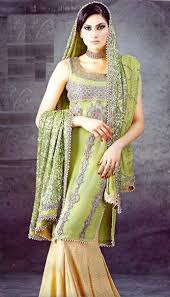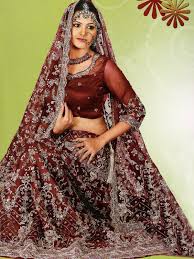Source (Google.com.pk)
Pakistani Bridal Dresses Pictures Biography












Pakistani Bridal Dresses Pictures Biography
Pakistani Bridal Dresses Designed
By Leading Pakistani Fashion Dress Designers. The Dresses included In This
Category Are Pakistani Bridal Lenghas, Pakistani Bridal Sarees And Pakistani
Bridal Ghararas. Get Your Elegant And Perfect Wedding Wears.
Ghara gharoli The decorated pitcher of water (ghadoli) is brought for the bride's bath by the groom's bhabi (brother's wife). In the Ghara Gharoli ritual, the bride’s sibling or sibling’s spouse visits the nearby temple and fills a pitcher with holy water. The girl is then bathed with this holy water. Thereafter, the bride wears their wedding attire.The ghara gharoli and the vatna ceremonies take place at the groom’s house too. But over there, the boy’s sister-in-law brings the pitcher of water. As per the tradition, their wedding dress is presented to them by their respective maternal uncles.
The Rut Jugga In this ceremony, the family dances and sings in the beautifully decorated wedding home. Rut Jugga is celebrated in the last hours of the night. They decorate copper or brass vessel called "gagger" with diyas (clay lamps) and fill them with mustard oil and light them. The bride/bridegrooms maternal aunt (mammi) carries it on her head, and another lady will have a long stick with bells, and she will be shaking it. The ladies will then go into other friends and families homes and be welcomed by sweets and drinks, they will then dance there and move on. It is a loud ceremony, filled with joy, dancing, fireworks, and food.
The Rut Jugga In this ceremony, the family dances and sings in the beautifully decorated wedding home. Rut Jugga is celebrated in the last hours of the night. They decorate copper or brass vessel called "gagger" with diyas (clay lamps) and fill them with mustard oil and light them. The bride/bridegrooms maternal aunt (mammi) carries it on her head, and another lady will have a long stick with bells, and she will be shaking it. The ladies will then go into other friends and families homes and be welcomed by sweets and drinks, they will then dance there and move on. It is a loud ceremony, filled with joy, dancing, fireworks, and food.
A young nephew or cousin also dons similar attire as the groom. He is called the sarbala/shabbala (caretaker of the groom) and accompanies him.Groom riding a horse with his sarbala.
Like the bride’s home, the Vatna and Ghara Gharoli are followed by the dressing up of groom in his wedding attire. After the groom has dressed up in his wedding clothes, a puja is performed. Thereafter, the groom’s father or any elderly relative ties the sehra on the groom’s head. After the completion of Sehrabandi ceremony, all those who witness the function give gifts and cash to the boy as a token of good luck.
Varna Varna is a ceremony that is supposed to ward off the evil eye. The groom's bhabi lines his eyes with surma (kohl).
The Ghori Chadna is the final ceremony at the groom’s place. The groom’s sisters and cousins feed and adorn his mare. To ward off the evil eye, people use cash and perform the Varna ritual. The cash is then distributed among the poor. After this the boy climbs the horse and leaves his home for the wedding venue.
Like the bride’s home, the Vatna and Ghara Gharoli are followed by the dressing up of groom in his wedding attire. After the groom has dressed up in his wedding clothes, a puja is performed. Thereafter, the groom’s father or any elderly relative ties the sehra on the groom’s head. After the completion of Sehrabandi ceremony, all those who witness the function give gifts and cash to the boy as a token of good luck.
Varna Varna is a ceremony that is supposed to ward off the evil eye. The groom's bhabi lines his eyes with surma (kohl).
The Ghori Chadna is the final ceremony at the groom’s place. The groom’s sisters and cousins feed and adorn his mare. To ward off the evil eye, people use cash and perform the Varna ritual. The cash is then distributed among the poor. After this the boy climbs the horse and leaves his home for the wedding venue.
In regional clothing, Balochi women wear heavy embroided Shalwar Kameez and Dupatta according to the weather conditions. They wear Kameez full of heavy Embroided Shisha work. Sindhi costumes have different styles of embroidery and some women use Ajrak as Dupatta. these women also wear bangles in their traditional way. Punjabi women prefer lite embroidery on simple Shalwar Kameez or Kurta. Traditional Lacha and Bangles are also used. Paranda is the special traditional, colorful and unique Punjabi item which is used to tie the hair. Pathan women wear embroided Kameez with a farak with a heavy Dupatta
Pakistani Bridal Dresses

Pakistani Bridal Dresses

Pakistani Bridal Dresses

Pakistani Bridal Dresses
Pakistani Bridal Dresses
Pakistani Bridal Dresses

Pakistani Bridal Dresses

Pakistani Bridal Dresses
Pakistani Bridal Dresses

Pakistani Bridal Dresses
Pakistani Bridal Dresses

Pakistani Bridal Dresses

Pakistani Bridal Dresses
No comments:
Post a Comment